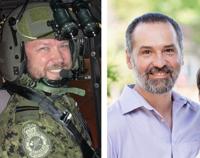CALGARY - Public health investigators and scientists in Alberta are working like detectives ã interviewing people, gathering evidence and waiting for lab test results ã to find out what caused a massive E. coli outbreak at several daycares.
"Just like a criminal investigation, the idea is the same," said Siyun Wang, an associate professor of food safety engineering at the University of British Columbia.
"If you find the same DNA fingerprinting in the crime scene and on the suspect, then that's the most straightforward link ã the smoking gun."
But Wang and other experts say definitive answers may be hard to come by.
As of Wednesday, there have been 310 lab-confirmed cases of the bacterial infection since the outbreak at 11 Calgary daycares was declared Sept. 4.
Twenty-one children were still in hospital, with 20 having hemolytic uremic syndrome, a complication affecting the blood and kidneys. Seven patients were on dialysis at Alberta Children's Hospital.
Dr. Tania Principi, section chief of pediatric emergency medicine at the hospital, said the increase in overall numbers is mostly due to a delay in getting lab results.
"Clinically, in the emerg, we're seeing a decrease in (the) number of children presenting with illness," she said.
Alberta's chief medical officer of health has said a central kitchen serving the daycares is almost certainly the source of the infections.
Investigations into what ultimately cause E. coli outbreaks can be complex, involve a lot of lab work and donãt always nail down a cause, said Timothy Sly, an epidemiologist and professor emeritus at Toronto Metropolitan University.
ãYou are trying to find the same organism with the same fingerprint,ã he said.
But he said thereãs always one source at the beginning of such outbreaks: cattle.
For water-borne E. coli outbreaks, the water source is contaminated by runoff from cattle feedlots. Romaine lettuce outbreaks happen because the leafy green is grown next to where cattle eat. Apple juice outbreaks are from cattle wandering through orchards.
But, as Sly suspects may be the cause in Calgary, often it's directly from the source: undercooked beef.
Piecing together the puzzle isnãt straightforward, he said. Investigators have to look to food handlers, those infected and the food itself.
"You can say it's E. coli, but you have to go further to find out which strain,ã he said.
Sly said samples will have been collected from people who work in the kitchen servicing the daycares and those infected with E. coli.
People in the lab will be looking to connect genome markers to find the same strain. Then food samples from the kitchen will be tested for a match.
ãTo identify the actual source of the E. coli, you would need to isolate the outbreak strain from one of the foods that was served,ã said Michael Gaenzle, professor and Canada Research Chair in the University of Alberta's department of agricultural, life and environmental sciences.
The bacteria related to this outbreak is Shiga toxin-producing E. coli 0157. Less than 10 cells can make a person sick, Gaenzle said. It's also difficult to identify in food because there are a trillion bacterial cells in a gram. On top of that, the food served may have already been thrown out.
"You are looking for the needle in the haystack,ã he said.
Dale Chen, program head of the British Columbia Institute of Technology environmental public health program, said some kitchens that serve vulnerable populations, such as hospitals, keep food samples for testing just in case there is an outbreak or illness.
"Every place is different in how they operate, how they store the food and what the facility is like," he said.
"All those little pieces need to be put together before a clear picture can be drawn."
If there are no good samples from food, Gaenzle said experts will go back to conventional wisdom about E. coli outbreaks.
The size and scale of the Calgary outbreak means it's unlikely cross-contamination or cockroaches found in the kitchen were the main cause, he said. That leaves experts looking to food.
Leafy greens like lettuce and spinach were also less likely to be the source, Gaenzle said. If it was greens, other people who purchased the produce would be getting sick.
Gaenzle said he suspects investigators will find a link to undercooked beef. It would explain the sickness being contained within the daycares, and parents have said their children were served meat loaf in the days before the sickness spread.
"That's reasoning based on a pattern of past outbreaks,ã Gaenzle said.
Alberta Health Services has not confirmed what food children at the daycares were served, but an online menu listed meat loaf, fresh vegetables and fresh fruit that week.
Investigations can take weeks, Gaenzle said, and people with the health authority have told him the labs are swamped and a definitive answer matching food samples to those infected may never come.
Gaenzle said the outbreak shows there needs to be improved oversight for food service companies, especially those that cater to daycares. A report detailing health violations at the central kitchen earlier said inspectors found improper sanitation, live cockroaches and issues around food handling.
Ultimately, he said, the lesson may be "humans make mistakes."
Dr. Francesco Rizzuti, medical officer of health for Calgary, said the closure orders have officially been rescinded for the daycares.
"Our AHS inspectors visited all 11 daycares to review conditions in each facility and ensure they met requirements for safe operation under the Public Health Act," he told reporters Wednesday afternoon.
A spokesman for the daycares said in an email that the well-being of the children, parents and staff remains the priority and noted the daycares had extensive cleaning and sterilization before Wednesday's reopening.
"All food will be provided by parents or sourced by external providers," said Kent Hehr, who's a vice-president with Fueling Brains.
Rizzuti said the central kitchen will not be allowed to reopen until the public health violations are fully addressed.
"Our investigation into the source of the illness continues," he said. "We have not identified a food source at this point."
The most likely source, he added, is food distributed from the central kitchen.
ã By Kelly Geraldine Malone in Saskatoon, with files from Colette Derworiz in Calgary.
This report by üСÜꪤüýò¿Øéóæòêü was first published Sept. 13, 2023.








































